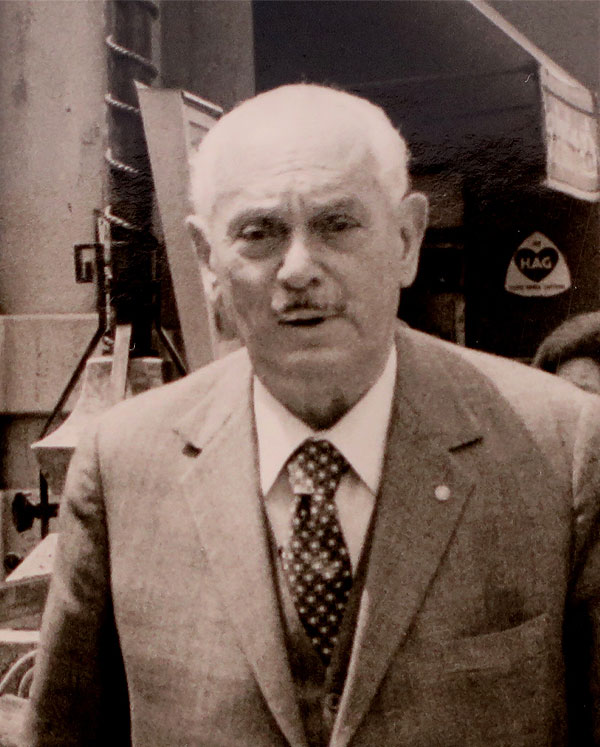Giulio Vicari, 1898/1975, and Wilhelm Schmid, 1892/1971, are two honorary citizens of Brè sopra Lugano.
Giulio Vicari has given much to the town, and the presence of an aqueduct in Brè is thanks to his efforts. On 21 October 1946 the “Municipality of Brè” addressed him in a document stating: in awareness of all that you have done thus far and will certainly do again, with commendable selflessness and love, for the good and the development of our town and especially with regard to the question of drinking water, we feel it our duty to express our heartfelt thanks and our deep gratitude and appreciation on behalf of the population.
He also supported the institution of the kindergarten.
We should not forget the fresco by Luigi Taddei on the wall of the church, which can be seen when going up the municipal road, or his contribution to the clock tower and much more. Because of these and many other initiatives, following a proposal by the municipality during a meeting on 15 February 1954, the Brè Town Council unanimous voted to confer honorary citizenship of the municipality of Brè on Hon Giulio Vicari, citizen and Mayor of Castagnola.
He also supported the institution of the kindergarten.
We should not forget the fresco by Luigi Taddei on the wall of the church, which can be seen when going up the municipal road, or his contribution to the clock tower and much more. Because of these and many other initiatives, following a proposal by the municipality during a meeting on 15 February 1954, the Brè Town Council unanimous voted to confer honorary citizenship of the municipality of Brè on Hon Giulio Vicari, citizen and Mayor of Castagnola.


Another honorary citizen of Brè is Wilhelm Schmid from Remigen near Brugg, in the canton of Aargau.
He was an artist who belonged to the “New Objectivity” cultural artistic movement, a form of German painting that arose after Expressionism in Germany during the 1920s, before the advent of Nazism. This group boasted of names such as Otto Dix, George Grosz, Christian Schad, Conrad Felixmüller, Rudolf Schlichter and Max Beckmann. Wilhelm Schmid was an artist who gave his characters more romantic and less aggressive tones, following a poetic style inspired by the small everyday things and rural life he found in the village of Brè.
In 1914 he held an exhibition at the Kunsthaus in Zurich, showing works that did not escape the attention of critics and when the First World War was over he became a prominent figure in the art world of Berlin. In 1918 he was one of the founders of the “November Group” movement in Berlin, the members of which included writers, musicians, painters and architects such as Max Pechstein, César Klein, Arthur Segal, etc. From 1924 to 1931 he moved to Paris, where he was the only Swiss artist to be considered by the “Salon du franc”. He returned to Potsdam in Germany, but the rise of the Nazis created an atmosphere that made it more and more difficult for him to stay in the Third Reich, and in 1936 a hostile campaign labelled him a “cultural Bolshevik” and a “degenerate artist”. He decided to settle in Brè sopra Lugano, which he had known since 1919.
Upon his death, Wilhelm Schmid left the Municipality of Lugano all of his work, his library and the house in which he lived.
He was an artist who belonged to the “New Objectivity” cultural artistic movement, a form of German painting that arose after Expressionism in Germany during the 1920s, before the advent of Nazism. This group boasted of names such as Otto Dix, George Grosz, Christian Schad, Conrad Felixmüller, Rudolf Schlichter and Max Beckmann. Wilhelm Schmid was an artist who gave his characters more romantic and less aggressive tones, following a poetic style inspired by the small everyday things and rural life he found in the village of Brè.
In 1914 he held an exhibition at the Kunsthaus in Zurich, showing works that did not escape the attention of critics and when the First World War was over he became a prominent figure in the art world of Berlin. In 1918 he was one of the founders of the “November Group” movement in Berlin, the members of which included writers, musicians, painters and architects such as Max Pechstein, César Klein, Arthur Segal, etc. From 1924 to 1931 he moved to Paris, where he was the only Swiss artist to be considered by the “Salon du franc”. He returned to Potsdam in Germany, but the rise of the Nazis created an atmosphere that made it more and more difficult for him to stay in the Third Reich, and in 1936 a hostile campaign labelled him a “cultural Bolshevik” and a “degenerate artist”. He decided to settle in Brè sopra Lugano, which he had known since 1919.
Upon his death, Wilhelm Schmid left the Municipality of Lugano all of his work, his library and the house in which he lived.









